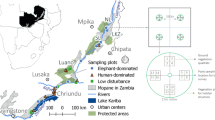Abstract
Sustained elephant browsing and intense burning could result in the loss of woodlands under conditions where elephant densities are high, such as in northern Botswana. Three woodland types dominated by Acacia erioloba, Baikiaea plurijuga and Colophospermum mopane were monitored in plots and contemporary recruitment rates of woody plants were compared with the associated local elephant densities and fire occurrences. Woodland types differed with respect to structure, extent of elephant damage and the occurrence of fire. Canonical correlations indicated that high extent of fire damage and high elephant densities did not covary within the woodland types investigated. Low tree densities in some woodland types were associated with high elephant densities and new elephant damage to plants increased with high elephant densities during the dry season. Plots with an apparent high fire frequency had lower tree densities and higher cover abundance of shrubs and seedlings.
The annual rates of tree recruitment/loss in each woodland type were estimated through a model based on observed seedling recruitment, mortality and reversal to lower height classes due to combinations of fire occurrence and elephant browsing. The model suggested that elephants induce tree loss in woodlands dominated by plant species which are principal food sources. Fire however, seems to have a widespread effect across woodlands which could result in extensive tree loss.
Similar content being viewed by others
References
Anderson, G. D. & Walker, B. J. 1974. Vegetation composition and elephant damage in the Sengwa Wildlife Research Area, Rhodesia. J. S. Afr. Wildl. Mgmt. Assoc. 4: 1–14.
Barnes, R. W. 1983. Effects of browsing on woodlands in a Tanzanian National Park: measurements, models, and management. J. Appl. Ecol. 20: 123–126.
Ben-Shahar, R. 1993. Patterns of elephant damage to vegetation in northern Botswana. Biol. Conserv. 65: 249–256.
Bhalotra, Y. P. R. 1987. Climate of Botswana. Meteorological Services, MWTC, Gaborone, Botswana.
Calef, G. W. 1988. Maximum rate of increase in the African Elephant. Afr. J. Ecol. 26: 323–327.
Caughley, G. 1976. The elephant problem — an alternative hypothesis. E. Afr. Wildl. J. 14: 265–283.
Child, G. 1968. An ecological survey of northeastern Botswana. FAO No. TA2563, Rome, Italy.
Craig, C. G. 1990. Present population and distribution of elephants in Botswana. The future of Botswana's elephants. Proceedings of the Kalahari Conservation Society, Gaborone, Botswana.
Croze, H., Hillman, A. K. K. & Lang, E. M. 1981. Elephants and their habitats: how do they tolerate each other. pp. 68–95. In: Fowler, C. W. & Smith, T. D. (eds) Dynamics of Large Mammal Populations, Wiley, NY, USA.
Dublin, H. T., Sinclair, A. R. E. & McGlade, J. 1990. Elephants and fire as causes of multiple stable states in the Serengeti-Mara woodlands. J. Anim. Ecol. 59: 1147–1164.
Guy, P. 1976. The feeding behaviour of elephant (Loxodonta africana) in the Sengwa Area, Rhodesia. S. Afr. J. Wildl. Res. 6: 55–63.
Guy, P. 1989. The influence of elephants and fire on a Brachystegia-Julbernardia woodland in Zimbabwe. J. Trop. Ecol. 5: 215–226.
Hutchins, D. G., Hutton, S. M. & Jones, C. R. 1976. The geology of the Okavango Delta. Proceedings of the Symposium on he Okavango Delta and its Future Utilization. Botswana Society, National Museum, Gaborone, Botswana.
Jachmann, H. 1991. Evaluation of four survey methods for estimating elephant densities. Afr. J. Ecol. 29: 188–195.
Laws, R. M., Parker, I. S. C. & Johnstone, R. C. B. 1975. Elephants and their habitats. Clarendon Press, Oxford, UK.
Lewis, D. M. 1991. Observations of tree growth, woodland structure and elephant damage on Colophospermum mopane in Luangwa Valley, Zambia. Afr. J. Ecol. 29: 207–221.
McLanahan, T. R. 1986. Quick population survey method using faecal droppings and a steady state assumption. Afr. J. Ecol. 24: 37–39.
Melton, D. A. 1985. The status of elephants in northern Botswana. Biol. Conserv. 31: 317–333.
Moroka, D. N. 1984. Elephant-habitat relationships in northern Botswana. DWNP, Gaborone, Botswana.
Norton-Griffiths, M. 1979. The influence of grazing, browsing, and fire on the vegetation dynamics of the Serengeti. pp. 310–352. In: Sinclair, A. R. E. & Norton-Griffiths, M. (eds) Serengeti: Dynamics of an Ecosystem. University Press, Chicago, USA.
Pellew, R. A. P. 1983. The impacts of elephant, giraffe, and fire upon the Acacia tortilis woodlands of the Serengeti. Afr. J. Ecol. 21: 41–74.
Sommerlatte, M. W. L. 1976. A survey of elephant populations in north-eastern Botswana. FAO Project Bot 72/020. Department of Wildlife an National Parks, Gaborone, Botswana.
Ter-Braak, C. J. F. 1987. The analysis of vegetation environment relationships by canonical correspondence analysis. Vegetatio 69: 69–77.
Schlotzhauer, S. D. & Littell, R. C. 1987. SAS system for elementary statistical analysis. SAS Institute, Cary, North Carolina, USA.
Sommerlatte, M. W. L. 1976. A survey of elephant populations in north-eastern Botswana. FAO Project Bot 72/020. Department of Wildlife an National Parks, Gaborone, Botswana.
VanWyk, P. & Fairall, N. 1969. The influence of the African elephant on the vegetation of the Kruger National Park. Koedoe 9: 57–95.
Wyant, J. G. & Reid, R. S. 1992. Determining the age of Acacia tortilis with ring counts for South Turkana, Kenya: a preliminary assessment. Afr. J. Ecol. 30: 176–180.
Author information
Authors and Affiliations
Rights and permissions
About this article
Cite this article
Ben-Shahar, R. Woodland dynamics under the influence of elephants and fire in Northern Botswana. Vegetatio 123, 153–163 (1996). https://doi.org/10.1007/BF00118268
Accepted:
Issue Date:
DOI: https://doi.org/10.1007/BF00118268




